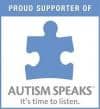by Lori Sichtermann
Even after finding success as a professional surfer, Scott McCranels, DMD, knew that orthodontics was his life’s passion
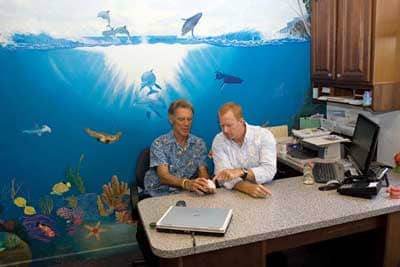
John R. McCranels, DDS (left), consults with his son Scott McCranels, DMD. Photos by Mark Hill
As a child growing up in the sunny beach community of Singer Island, Fla, Scott McCranels, DMD—”Dr Scott,” as he’s known by patients today—was raised on a steady diet of surfing and orthodontics. While this mixture would cause career indigestion in some, McCranels embraced both passions.
When it comes to surfing, McCranels gives full credit to his surroundings and to his father, John R. McCranels, DDS, who also surfed competitively before opening his own orthodontic practice in nearby West Palm Beach, Fla. “My dad is a living legend in surfing,” McCranels explains. “He’s a decorated competitor and honored judge in the sport, having been the United States champion in the amateur ranks and judging the world contest back in the 1960s.”
Being exposed to the competitive surfing scene from a young age, McCranels took the lifestyle as norm. “When you’re a little kid in that environment, it’s just a lot of fun,” he says. “You build a sand castle on the beach for a little while and then go out and surf. That’s all I knew. It wasn’t like I used to say I wanted to grow up and become a professional surfer. That idea came a little later.”
At the same time that McCranels was exposed to the joys of surfing, he also became familiar with the field of orthodontics. As he explains, he and his three siblings spent much of their youth at their father’s practice. “We hung out in the office after school on some days,” he recalls. “We always knew what was going on. We may have not known technical aspects of orthodontics, but we knew it was a fun atmosphere and other kids weren’t scared to go in there, unlike the dentist. It was a pretty fun place to be because it was so kid-oriented.”
PRACTICE PROFILE
Name: McCranels Orthodontics
Location: West Palm Beach, Fla
Specialty: Two-phase orthodontics
Patients per day: 40 to 50
Starts per year: 250
Years in private practice: 43
Days in private practice per week: 4
Lunch Break: 2 hours for surfing
Web site: mccranelsorthodontics.com
The time he spent in his father’s practice had a lasting effect on McCranels, and would ultimately lead to his decision to enter the profession. But first, there were waves to ride.
Going Pro
McCranels’ first entrÉe into professional sports did not include a long board and surf wax. “I was a professional skateboarder before I was professional surfer,” he explains. “I grew up surfing and skateboarding, and turned pro skateboarding in 1976—my freshman year in high school.”
Throughout his skateboarding career, McCranels continued to surf, competing on the amateur level in regional and local events. In 1984, after he entered college, McCranels made the switch to surfing full-time. Between his junior and senior years in college, he took a 3-year leave of absence from school to travel with the Association for Surfing Professionals’ World Tour.
During his first year on the World Circuit, McCranels scored as high as 12th in the world, which would be the highest ranking he would receive. “I stayed in the top 50 for 3 years, and my ranking would go up and down depending on the results of various competitions. But, after 3 years, I decided I hadn’t reached the personal goals that I wanted to achieve, so I went back to school and finished my last year.”
McCranels considered professions, such as architect or ocean biologist, but, he says, “Even after I traveled around the world with surfing, I realized that orthodontics was my calling. I had a good idea what was involved in it from my dad.”
While earning his undergrad degree and going to dental school, McCranels continued to surf competitively. “Surfing carried me through school, which was great,” he explains. “Just like any other dentist, orthodontist, or medical student, I had big tuition bills to manage. But, thanks to my career in surfing, I graduated from my dental school debt-free, which was a big deal. Surfing was my scholarship.”
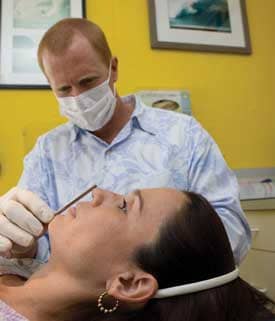
McCranels continued to surf competitively while in dental school. “Surfing carried me through
school, which was great,” he explains. “Just like any other dentist, orthodontist, or medical student, I had big tuition bills to manage. But,
thanks to my career in surfing, I graduated from my dental school debt-free, which was a big deal. Surfing was my scholarship.”
Relaxed and Respected
In 1967, John McCranels opened McCranels Orthodontics in West Palm Beach, Fla. From the beginning, McCranels Orthodontics embodied a different outlook than other practices in the area. The elder McCranels made a name for himself by offering patients a laid-back, yet professional, atmosphere.
Over the years, the casual concept caught on and the practice grew. In the mid 1970s, McCranels moved his practice to its current location—a multiroom house 3 minutes from the beach with views of Palm Beach’s intercoastal waterway. In 1995, Scott McCranels joined his father’s practice and embraced the professional philosophy already set in place: quality over quantity.
“For two doctors in the practice, we’re very low-volume,” McCranels notes. “We don’t have a staff of 15 or 20 who help us cycle through 100+ patients a day. It is more laid-back. Instead, we really value our relationships with each patient. We’re proud that we see patients on time and that we provide the best service possible to them.”
To help carry this message of relaxed professionalism, the office features a hodgepodge of surfer paraphernalia from the private collections of each orthodontist. From surfboard chart holders to wooden Tiki statues—one featuring straight teeth, the other crooked—the dÉcor of McCranels Orthodontics sets the tone for the patient’s experience.
According to McCranels, the practice referrers to itself as the McCranels Orthodontics Surf Club. “The kids who come into the practice for the first time get a T-shirt with our surf club logo on it,” he explains. “They think it’s cool, whether they surf or not.”
Doing Whatever Works
McCranels Orthodontics is distinguished not just by its laid-back, father-son orthodontist duo or its surfer design motif, but also by the practice’s clientele and the types of services these patients receive.
As McCranels explains, most orthodontists do standard, comprehensive treatment. However, at the McCranels’ practice, the doctors perform two-phase orthodontics, meaning early treatment for Phase 1. “There are some orthodontists who don’t believe in early treatment,” he adds. “That’s fine, but it’s a practice philosophy of ours.”
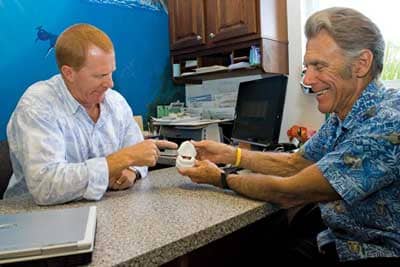
“For two doctors in the practice, we’re very low-volume,” McCranels notes of the practice he runs with his father pictured at right), a fellow surfer. “We don’t have a staff of 15 or 20 who help us cycle through 100+ patients a day. It is more laid-back. Instead, we really value our relationships with each patient.”
Another area of orthodontics in which the McCranels differ from other practices is in their use of the Invisalign technology. According to McCranels, the McCranels have embraced this (relatively new) technology for the sake of their clientele. As he explains, the patient profile of McCranels Orthodontics includes 65% to 70% children and 30% to 35% adults. “We have a lot of professionals in our area who are involved in finance or who practice law,” McCranels adds. “These patients will not have braces as an adult. Therefore, the Invisalign option brings them to our office. If braces were their only option, they would bypass the needed orthodontic work.”
A willingness to adopt new technology has played a substantial role in the success of McCranels Orthodontics. “We try to keep an open mind when it comes to embracing new technologies in the field,” McCranels says. “As orthodontists, we’re trained to move teeth from point A to point B. What we use to move the teeth is up to the needs of the patient as well as the orthodontist’s capabilities.”
Creating Smiles
In addition to correcting smiles, McCranels has spent years creating them. For more than a decade, he’s worked with the nationwide charity Smiles Change Lives, a Kansas City, Mo-based nonprofit that helps kids from low-income families receive orthodontic care.
When the organization expanded to Florida, McCranels was contacted to contribute his orthodontic services. Shortly thereafter, he joined the local advisory board for the organization. After several years of service, McCranels joined the organization’s national advisory board, taking the message of help to a larger audience.
Record Breakers
In addition to sharing a successful orthodontic practice, the McCranels father-son duo also share an interesting surfing record. They are the first father-son team to be featured in the East Coast Surfing Hall of Fame.
After a lifelong relationship with the sport—serving as a competitor and a respected judge in local, regional, and national competitions—John R. McCranels, DDS, became a spokesperson of sorts for the surfing community in Florida. Years ago, legislators attempted to ban surfing in the state, and McCranels helped fight the ban. “Surfers were kind of hippies and rebels back then,” says the younger McCranels. “And, because my dad was a doctor, he ended up being more of a spokesperson in the surfing community.”

In 2010, Scott McCranels, DMD, was inducted into the same surfing Hall of Fame. As he explains, his induction was based more on his success as a professional in the sport. “In 1984 I made it to third place in the OP Pro held here in Florida. Then, in 1987 and 1988, I took home first place at the East Coast Surfing Championship, the longest-running surfing contest in the world.”
Today, the father-son team continues to surf as often as possible, but operating a successful orthodontic practice has taken center stage for both. “It’s somewhat of a catch-22,” McCranels explains. “We try to surf together, but we often have to take separate vacations because one has to cover the office while the other is away. However, every once in a while, we’ll go out together and have a good time.”
“I was honored to serve on the national advisory board for 8 years,” McCranels says. “The organization is a great mechanism that provides orthodontics to families that really need it.”
As McCranels explains, Smiles Change Lives has a system to screen patients and identify which applicants are most in need, medically and financially, of free orthodontic care. “If a doctor is going to do pro bono work, they want to make sure they’re doing it for families who need it the most,” he says. “Doctors don’t have time to do this kind of research, so the organization identifies in-need families for a doctor. It’s a great way to get help to where it’s needed the most.”
The McCranels family goes right to the source in other charitable ways as well. For several years, the McCranels’ practice has taken part in the Adopt-A-Class Program, which provides financial aid to area schools in West Palm Beach.
“We adopt a teacher each year and donate an estimated $250 directly to that teacher so he or she can purchase teaching aids,” McCranels explains. “Teachers are always underfunded, and this is a great way to help our schools and to lessen the burden on teachers. We’ve been doing this for years, and we’ve been impressed with the difference it makes in the schools.”
What’s Next?
After many successful years of taking part in and giving back to the Florida surfing community, the senior McCranels was inducted into the East Coast Surfing Hall of Fame in 2002.
After 15 years of sharing in the orthodontic profession with his father, McCranels has seen some heavy-hitting changes in the industry as well as some clear signs of where the field is heading. “Braces have been around for a hundred years, and they’re certainly not going anywhere. However, I think technology in orthodontics is going to make some quantum leaps in the next several years,” he says.
One such element that McCranels sees surfacing is digital scanning. “Digital impressions using x-ray wands will be in use within the next 5 years,” he predicts. “Hopefully, by that time, we won’t be using impression material anymore. With all the computer speed, power, and capabilities, we should be able to handle all of this information digitally. Why not have the 3D models of the patient’s mouth? Why can’t that be easier and more efficient?”
Although they stay up to date and embrace new forms of technology, McCranels and his father are cautious not to overdo it. They’ve built a solid business on being knowledgeable in their field as well as personalized in their demeanor. To lessen the focus on either of these aspects would go against the nature of their practice.
“You can have as much technology as you want within your practice, but if you don’t have that personal touch with people, you’re not going to succeed in business,” McCranels says. “Anyone can come in and purchase bells and whistles. If you don’t give personal attention to the people, they’ll read right through that and go somewhere else.”
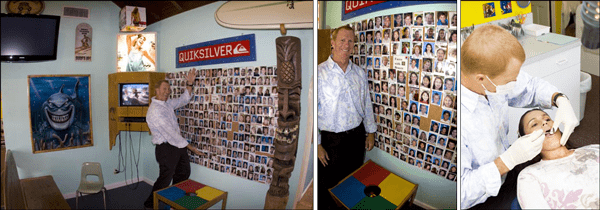

Lori Sichtermann is a contributing writer for Orthodontic Products. For more information, contact




